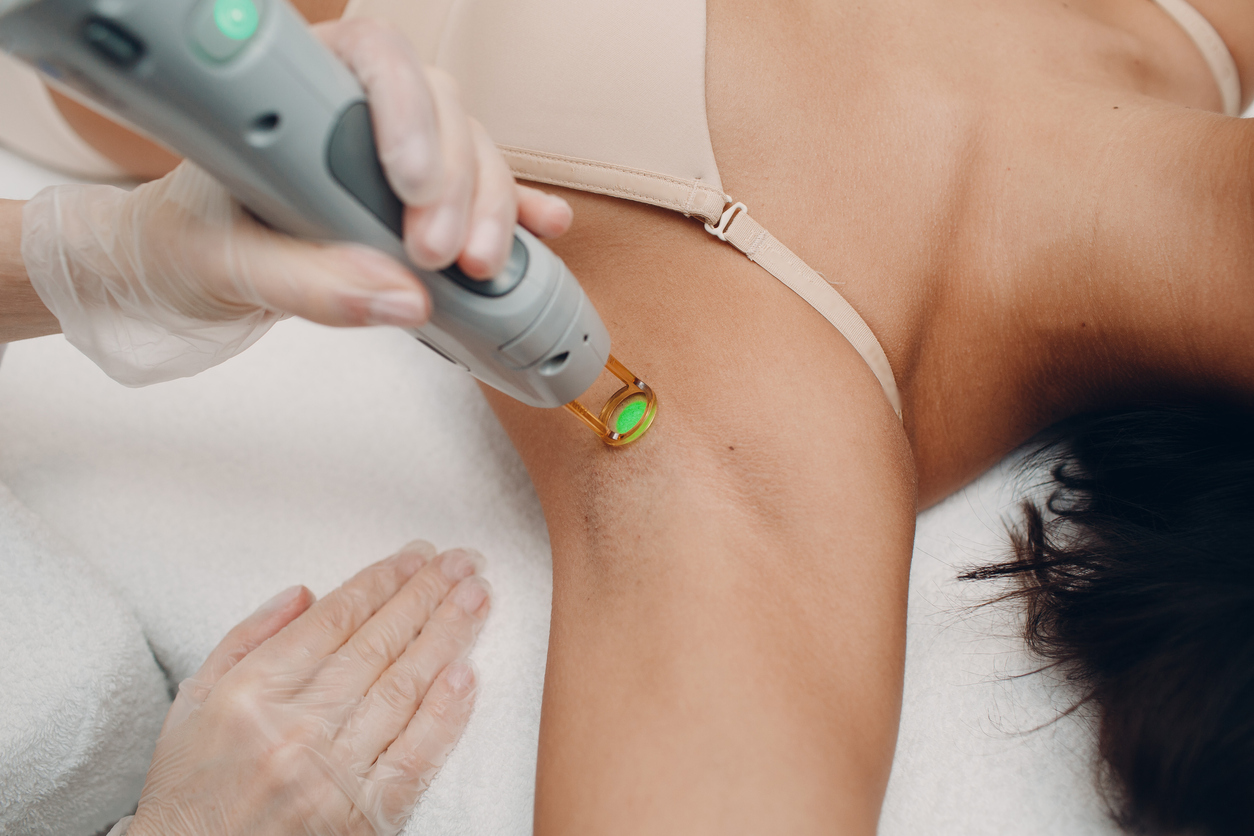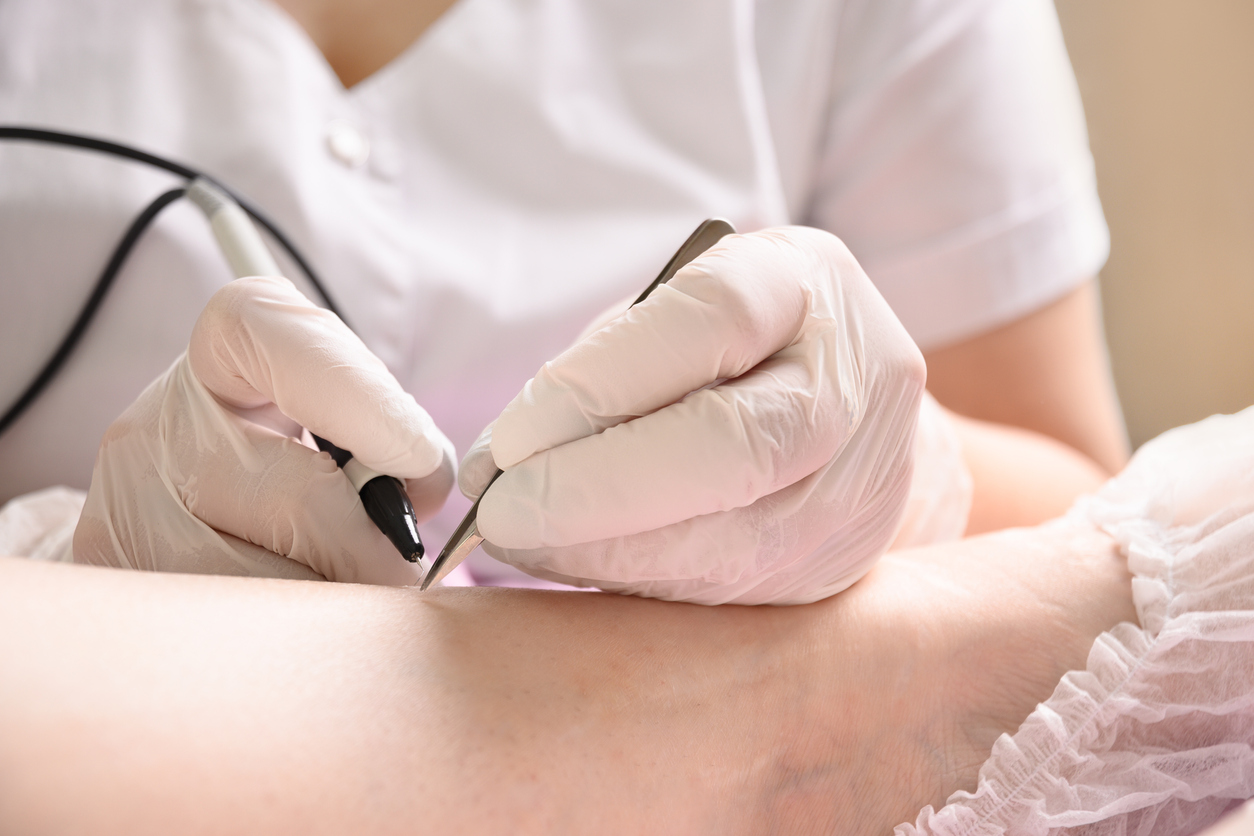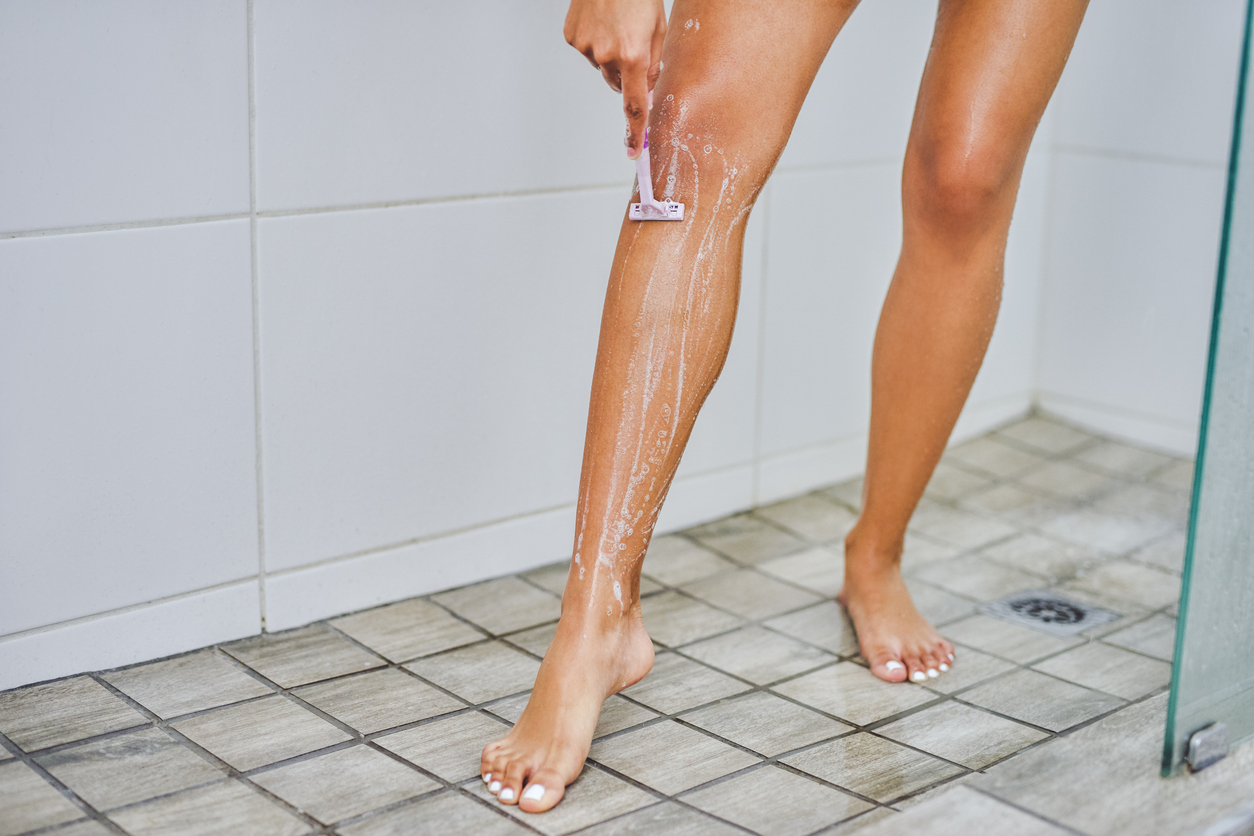There are so many hair removal methods to choose from, it can be hard to know which one is right for you. It can also be frustrating to try lots of different ones, only to have to keep removing your hair every few days or weeks. If you’re looking for something long-lasting, laser hair removal or electrolysis is an option.
You might want to try these hair removal methods if you have hirsutism (a condition that causes excessive hair growth), which can happen when you get hormonal changes in menopause, or be caused by a health condition like polycystic ovary syndrome (PCOS). Or you could be tired of having to wax, pluck or shave, and would prefer a longer-term solution. You may be going through gender presentation changes or reassignment and looking into hair removal techniques as part of this process.
Whatever your reason, keep reading to discover the pros and cons of these popular long-term hair removal techniques.
Laser hair removal
What is laser hair removal?
Laser hair removal is a type of semi-permanent hair removal that uses a powerful laser to destroy hair follicles at the root. Over time, this method stops the hair from growing as quickly or as much as it did before.
There are several types of lasers used. The most common are:
- Alexandrite
- Diode
- Neodymium YAG
- Ruby
- Intense pulsed light (IPL) – this isn’t a laser, but works in the same way. It works best on light skin and dark hair, and can cover large areas of skin quickly
All lasers work best on lighter skin with darker coloured hair, because the laser targets the pigment in the hair. As technology has advanced, there are now smarter lasers that work on people with dark skin tones but side effects can be more likely. The only people that aren’t suitable for laser hair removal are those with grey or very light hair.
Will laser hair removal work for me?
Generally, laser hair removal works best on people with pale, light-coloured skin and dark hair. Newer lasers can be used on people with dark skin tones and hair but how well the laser works ultimately depends on the type of machine and the wavelength used as well as your skin and hair colour, so results vary.
Before you decide whether to opt for laser over electrolysis there are other pros and cons to consider, including cost, pain and how long it will last:
Pros of laser hair removal
- the cost – although laser hair removal can be expensive, it often costs less than electrolysis. The exact cost of your treatment will depend on the area(s) you’re having treated and how many sessions you’ll need. Your practitioner will be able to advise on this and can work out a package for you
- can be used on most areas of the body – including large areas of skin, like the back and more sensitive areas like the face
- there can be minimal pain – some people say that laser treatment feels like a slight stinging or tingling feeling but generally it isn’t painful. Levels of pain can also depend on which area you’re having treated
- instant results – this depends on a few different things, but you could see a 10 to 25% decrease in hair after your first session
- it’s usually safe – laser hair removal is safe and generally only causes mild side effects that only last 1 to 3 days, like mild pain, discomfort, swelling and redness
Cons of laser hair removal
- it takes time – lasers aren't a quick fix. To be effective, you’ll probably need several treatment sessions – usually 2 to 6 but it can be more. These are usually a number of weeks apart so treatment from beginning to end may take a few months
- it’s not permanent – laser hair removal reduces the amount of hair you have over time, rather than removing it completely. There’s also no guarantee it will work on all your hair and you’ll need top up sessions to stop the hair regrowing
- it may not be suitable during pregnancy – laser hair removal may not be suitable if you’re pregnant or trying for a baby, so speak to your clinician before starting treatment

What the treatment involves and what to expect
- You don’t need to get fully undressed for your treatment but make sure you expose the treatment area.
- Before your treatment begins your clinician will cleanse the area and may apply a cooling gel or spray.
- If you have sensitive skin and are only having a small area treated, you might have a numbing gel applied 30 to 60 minutes before your treatment.
- Your clinician should be wearing goggles and also give you a pair to protect your eyes from the laser.
- During the treatment, your skin should be held taut.
- The laser vaporises the hair as it passes over the skin so you may notice small plumes of smoke and a smell of burnt hair – this is nothing to worry about.
- Sessions can take anywhere from a few minutes to over an hour, depending on the area(s) being treated.
- After the treatment, your clinician will apply a cooling gel like aloe vera to help cool your skin and reduce any redness and irritation.
Getting the best from this method
There are a few things you can do to make sure your laser hair removal treatment is as effective as possible. Part of this is making sure you know how to prepare for treatment and how to care for your skin afterwards. Follow these tips:
Before treatment
- avoid waxing, sunbathing, tanning beds, collagen injections or chemical peels for 2 weeks before your treatment
- you also shouldn’t use deodorant, perfumes, scented products or bleaching creams on the day of your treatment
- shave the area being treated the day before your treatment so the laser can effectively target the hair follicle
- wear loose, comfortable clothes that you don’t mind getting creams or gels on. This will help the clinician access the area being treated and help minimise irritation afterwards
After treatment
- avoid using deodorant, perfumes, scented products and bleaching creams for 48 hours afterwards
- apply a thin layer of aloe vera on the treated area a few times a day to help with healing and to reduce irritation
- don’t take aspirin, herbal supplements and anti-inflammatory drugs on the day of and for a few days after treatment as it can increase the risk of bleeding
- avoid hot showers, baths, steam rooms or saunas, or going swimming, for 2 to 3 days
- avoid exfoliating or using peels for 1 week
- wear loose fitting clothing for 2 or 3 days to avoid irritation
- hold an ice pack wrapped in a towel to your skin if it is red or you have a rash
- don’t rub or scratch the area that’s been treated
- your skin will be more sensitive to the sun after treatment, so try to keep it out of sunlight until your course of treatment has finished and always wear SPF30, whatever the weather
Electrolysis
What is electrolysis?
Electrolysis is a permanent type of hair removal. A fine needle goes into the skin and supplies a small electrical current that damages and eventually destroys the hair follicle.
There are 3 types (modalities) of electrolysis used:
- galvanic – which destroys the hairs using a chemical reaction
- thermolysis (short-wave) – which destroys the hairs using heat
- the blend – a combination of galvanic and thermolysis
Will electrolysis work for me?
Electrolysis works on all skin and hair types, and on most areas of the body, so it’s likely it will work for you. How well it works also depends on the skill of the electrologist – electrolysis requires accuracy and use of the right intensity and duration of current.
Like with laser hair removal, there are things to think about when choosing this method.
Pros of electrolysis
- it’s permanent – electrolysis is the only hair removal method recognised as permanent by the FDA (US Food and Drug Administration)
- treatable areas – as well as working on all types of hair and skin, electrolysis can be used to remove hair from most body parts, including the face
- treatment times – sessions will get shorter as you go, as fewer hairs need to be treated over time
Cons of electrolysis
- the cost - electrolysis is one of the more expensive types of hair removal, and the full cost depends on how many sessions you need and the area treated. Your clinician can advise you on what you need
- it takes a long time – electrolysis sessions can be slow, as the electrologist often has to go back over the same hair follicle a few times. A full treatment plan to remove hair permanently can take around 18 months. This all depends on factors that can affect hair growth such as how you’ve removed hair previously, any medications you’re on and any hormonal problems you have
- skin irritation – your skin might feel red, tender or swollen for a few hours after treatment. You might also get small whiteheads or scabs in the treated area. Pigmentation changes and scarring are also potential side effects, and if you have darker skin, you could develop a keloid scar
- discomfort – electrolysis can be uncomfortable or painful, with people saying treatment can sting
- not suitable for everyone – electrolysis is safe for most but can’t be used by people with pacemakers, as it can cause abnormal heart rhythm

What the treatment involves and what to expect
- like with laser hair removal, you don’t need to get fully undressed – just make sure the area being treated is easily accessible
- the person giving the treatment (electrologist) should be wearing disposable gloves
- before starting the treatment they will clean the area of skin being treated
- during treatment, you’ll probably feel a bit of discomfort or stinging from the fine needle going into your skin. How this feels may differ depending on the area of the body being treated
- when the treatment has finished the electrologist will apply an antiseptic
- sessions can take anywhere from a few minutes to over an hour, depending on the size of the area being treated
Getting the best from this method
Before treatment
- don’t remove your hair as it can make the treatment less effective
- hair should be long enough for the electrologist to see (around 3 to 4 days of growth)
After treatment
- don’t wear makeup and avoid sweating lots for 24 to 48 hours as these can inflame the hair follicles
- stay out of the sun and avoid tanning after your treatment and until your skin heals
- if you are in the sun, apply at least SPF 30 sunscreen and reapply as needed to avoid slow healing and pigmentation marks
- avoid lotions, sprays, deodorant and powders for 24 hours unless they’ve been recommended by your electrologist, as they could irritate your skin don’t touch or pick at the area, even if crusts appear on your skin. Let them fall off on their own so your skin can heal naturally
- don’t swim, use saunas or have a hot baths or shower for at least 48 hours
- bathe the area in cold or iced water if it still feels hot
At home vs in clinic
Laser hair removal and electrolysis kits are widely available and can be cheaper, and more convenient, than in-clinic appointments. But it’s best to go to a trained specialist if you can, as they’ll design a treatment plan that suits your needs and use safe, high-quality equipment.
The small hand-held devices you can buy aren’t as powerful as those used in clinics, which can mean they’re not as effective, especially on larger areas. It’s always important to follow the instructions on your device as there may be areas or conditions it’s not safe to use with.
Electrolysis vs. laser: our verdict
Most effective and long lasting
While laser hair removal can last for a long time, it generally isn’t permanent. Electrolysis on the other hand is the only permanent hair removal method available today. It also works well on all types of hair and skin, including light-coloured hair, which laser hair removal doesn’t.
Best value
Laser hair removal may be cheaper in the short term but it only removes the hair temporarily, so you may need more maintenance sessions in the future that come at an additional cost.
Electrolysis may take longer and seem more expensive initially, but it’s the best value hair removal treatment, as it’s more likely to remove the hair permanently.
Least painful
Electrolysis can be more painful, as it stings every time a single hair is treated. Laser only causes a slight tingling or stinging sensation. With both, the level of pain also depends on the size of the area being treated.
Doctor tip
“If you’re going through gender presentation changes or reassignment, body and facial hair removal might be something you’re worried about. These more permanent solutions can be very helpful, but you may still need emotional support or want to meet people going through the same thing as you.” – Dr Adiele Hoffman, Clinical Content reviewer
Support groups and forums you might find useful:
Gender Identity Clinic
Mermaids UK
TransUnite
MindlineTrans
“If you are seeking hair removal methods for excess or unwanted hair because of the hormonal changes caused by menopause, or because you have hirsutism (a condition that causes excessive hair growth) or polycystic ovary syndrome (PCOS) it can be emotionally distressing. It might help to speak with other who are experiencing the same thing.” – Dr Ann Nainan, Clinical Content reviewer
You may find these charities useful:
Verity
Menopause Suport
The Menopause Charity







